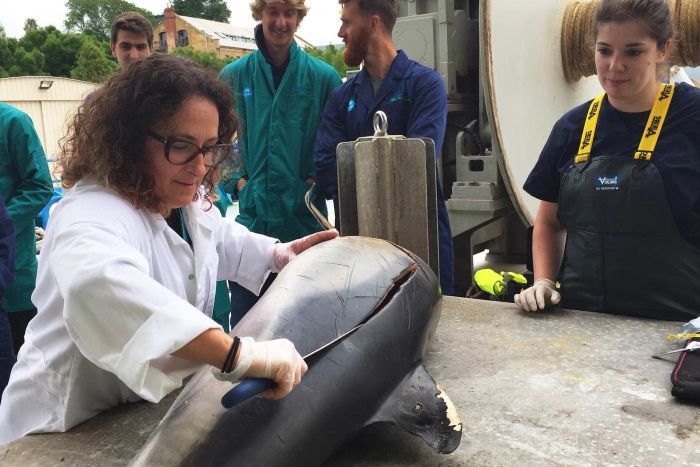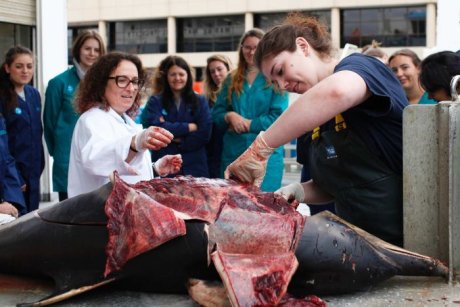This article originally appeared on ABC News. Read the original article here.
WARNING: this story contains images of a dolphin being dissected
Most kids remember dissecting a frog in science class at school.
But not everyone has witnessed a dolphin being carefully taken apart and examined.
It might seem a bit gory, but the necropsy was performed to better understand, manage and conserve the marine species.
Twenty-two students from the University of Tasmania joined researchers from the CSIRO and the Department of Primary Industries, Parks, Water and Environment (DPIPWE) for the event.

Dr Karen Evans cuts open on a common dolphin
Dr Karen Evans begins proceedings. ABC News: Aneeta Bhole
CSIRO’s Dr Karen Evans, who performed the necropsy on board the research vessel the RV Investigator, said “it’s a bit like forensics”.
“I compare it to CSI [crime scene investigation],” she said.
“You want to find out if anything has compromised the animal, if there’s any disease, but also you’re also trying to find out a bit more about the species.”
The subject of the study died after becoming stranded.
“Animals like this live their whole lives in the ocean so we don’t have an opportunity to really study them,” Dr Evans said.
“Things like the stomach contents will tell us what the animal is eating and the state of the organs will tell us how healthy the animal is.”

Tasmanian student dissecting a dolphin
A lot can be learned from study of the flesh, organs and teeth of dead animals. ABC News: Aneeta Bhole
‘Fascinating, except for the smell’
While students agreed the dissection was informative, it was the smell that took them most by surprise.

UTAS students Sheridan Barrett and Alice Wanders at the dolphin dissection
UTAS students Sheridan Barrett and Alice Wanders at the dolphin dissection. ABC News: Aneeta Bhole
Alice Wanders said she “wasn’t horrified or disgusted” by the experience.
“It was fascinating, except for the smell, we didn’t expect it to smell this bad,” she said.
“This was a fairly fresh specimen so the smell isn’t as bad as an animal that’s been on a beach for a couple of days,” Dr Evans said.
“A really decomposed animal can smell like rancid parmesan cheese … [that is] the best way to describe it.”

Dr Karen Evans supervising a necropsy on a dolphin
Dr Karen Evans oversees the procedure, which took part on the CSIRO research ship Investigator. ABC News: Aneeta Bhole
The dolphin was donated by DPIPWE and had been sitting in a freezer for almost a year before the procedure.
Marine Conservation Program’s Kris Carlyon said the Environment Department takes samples and provides them for research worldwide.
“We get a standard set of samples from all whales and dolphins that we investigate,” he said.
“Normally we’re doing this procedure on a beach and we take some skin, some blubber, a range of internal organ samples, we take some teeth and each one of those samples gives us some specific information.”
Mr Carlyon said skin provides genetic information, blubber indicates toxins and potential pollutants that build up in the tissue, while teeth can reveal age of the animal.
“It all helps build a picture of the health of that animal, it’s ecology and what it’s been doing prior to stranding.”
This article originally appeared on ABC News


6th December 2017 at 7:54 pm
Years ago i found dolphin in the supermarket fridge in Japan …sooo…I bought some. I have a REALLY strong stomach and have eaten some very strange things but dolphin was truly an experience. It was a beefy texture which tasted like bad fish crossed with liver. It is definitely an acquired taste.
30th November 2017 at 11:19 am
Impressive surgical instruments 🙂